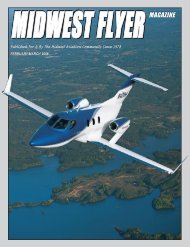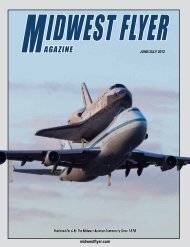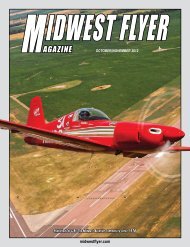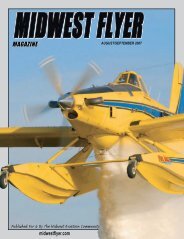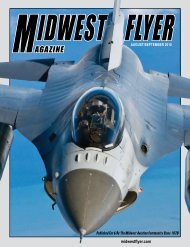FLIGHT TRAININGA Commentary On Advanced Avionicsby Harold GreenWe arecurrentlyin thethroes of a generalaviation revolution.We have airplanes thatcruise comfortablyat 24,000 feet at wellover 200 knots, haveHarold Greena range approaching1,000 miles, comeequipped with ice prevention, andprovide sophisticated electronics thatonly a few years ago were to be foundonly in the most sophisticated militaryand airline aircraft, if at all. Note:When such sophisticated capabilitywas available in the past, there weregenerally two pilots in the airplane. Infact, some things like uploaded weatherwere not available at any price justa few short years ago. Today we canwatch ourselves as the little airplanecrawls along the approach chart as weexecute an approach or even as we taxion the surface of the airport. We can,air traffic control permitting, virtuallyprogram our entire flight, including aninstrument approach, before we evenleave the ground. We still have to takeoff using our own muscles and brains,but once airborne, we need only push afew buttons and then sit back and enjoythe flight with the only effort on ourpart being to adjust the throttle(s). Thesystem will warn us of any potentialtraffic hazards throughout the flight,and during the flight, we can lookat radar weather uplinked from theground. Of course we are still taskedwith landing the airplane. In time,these systems will become even moresophisticated. Certainly from a puretechnology viewpoint, it would be easyto automate both the take off and thelanding.As with everything in life, theseadvances come at a price. There isa maxim in economics known asTINSTAAFL…There Is No SuchThing As A Free Lunch. That appliesto our avionics as well. There is theobvious cost of purchase and, of course,increased maintenance cost, andthen there is the cost associated withsatisfying the equipment’s insatiableappetite for up-to-date data. However,the two most important costs areincreased training and the need tomaintain our vigilance with respect totraffic and situational awareness.Please understand that in thispilot’s opinion, the advantages ofthese advances far and away overcomeany disadvantage, providing we learnhow to use the equipment withoutlosing track of airplane performance,other traffic and the demands thatAir Traffic Control places on us. As afurther caveat, let it be known that thedemise of the Very High FrequencyOmni directional Range, VOR, hasbeen prematurely reported. TheVOR is still around, and as specifiedin the Aeronautical InformationManual, paragraph 1-1-19, GeneralRequirements, an approved alternatemeans of navigation is required whenusing GPS equipment in IFR, and sinceNon-Directional Beacons are beingrapidly removed, the VOR is the mostlikely candidate. Therefore, the VORis likely to be around for as long as thisrequirement exists.The complexity issues are mostobvious when conducting IFRoperations. First, the simple old methodof finding the approach plate, twisting acouple of knobs and setting the OBS islong gone. Now we go through severalprocedures to select the approachand the initial fixes, and then activatethe approach. We still must have theapproach plate in front of us, be itLotsFor Sale!"#$!"#$0!""#$%$&'(&)*')+,)-"./0.""+123)&'"456)-"+#%#718)"""WI36 Dohlun Field - Lake Tomahawk, Wisconsin!"#$%&'($')$#&*%(%"+&$,%-.,/(!$0&(1"2$3$40-*(*"5%3&5*(6-7#"*7-*8!"#$%&'"()*#"+$,*-./012)3*)"4$50&"672849"!!!!!!!!"#$%!%$&'$()*!&$!+,-.///:*5'";
paper or electronic.Of course there is more to a glasscockpit aircraft than GPS. TrafficCollision Avoidance Systems (TCAS)are becoming commonplace as well.They are an excellent adjunct tosituational awareness. However, thereis a tendency to overreact to trafficdisplayed on these devices. This isparticularly true when operating ina terminal environment or when therange is set too wide. Those pilots whoare very traffic shy want to move awayfrom all targets, even those that aremiles away and not closing. The leanassist function available in some systemsprovides a great opportunity to ignorethe rest of the world while setting thefuel flow to one’s engine. My personalbest is the student who spent 7 minutesstudying the lean assist display whileignoring the airplane as the autopilotkept us on course and at altitude whileclipping along at 170 knots.Historically we work with distance:Distance to the next checkpoint,distance to the VOR, etc., etc. Nowthat the GPS can give us time to thewaypoint, most people set up the GPSdisplay to show distance because that iswhat we are used to. But airplanes don’tcare about distance…they only careabout time. We don’t run out of fuelbecause we fly too far. We run out offuel because we fly too long. A changein outlook might be in order here.The GPS flight plan page will showyou the time for each leg of your flight.Why not use it? Just for the record,we weren’t any better at using the timedisplay on the DME either, but it onlyshowed the time to the tuned VOR,whereas the GPS will show the time toeach waypoint in the flight plan.Another issue arises around the“autopilot.” In the past the FAA tookthe approach that if your plane had anautopilot, you had to fly the checkrideby hand and then prove that you knewhow to operate the autopilot. Now thephilosophy is that you fly the checkridewith the autopilot and prove that youcan fly the airplane by hand. This is adrastic change, but one necessitated bythe complexity of the avionics in ourairplanes today.These are just some of the issuesinvolving the new avionics. Along withthese there is the fact that complexityof systems tend to be greater than thesum of their parts. That is, when viewedas a system, the interaction betweenthe elements of the system creates theirown set of complexities. When oneelement is dysfunctional or incorrectlyprogrammed, there is an impact onother elements. Also, remember thatin airline operations, there are twopilots handling essentially the sameequipment, whereas we usually have butone.Today’s student is very well awareof the new technology and all too oftenwants to bypass the VOR trainingor anything involving not using themagenta (sorry, it’s still pink to me) lineon a display panel. It is so much easierat first to follow the pink line, then tovisualize a position relative to a VOR ora localizer transmitter.Because of these and other issuesarising out of this new technology, it isnecessary that we look at the trainingwe instructors provide students, andstudents need to be convinced that itis in their interest to learn not onlythe new technology, but the old aswell. It is worthy of note that when anew airplane is purchased, it usuallycomes with extensive factory checkoutin recognition of the complexity ofthe new systems. In fact, more time isspent on learning the advanced avionicssystems than in flying the airplane.This is a large help to the new owner.However, when a second or later ownerpurchases the airplane, the trainingissue becomes of concern again.Somehow the instructor must instillin the new owner and/or student pilot,a respect for, and understanding of,the complexity of the system whileretaining the ability to use the oldnavigational aids.I don’t pretend to have all theanswers here since each student bringshis or her own viewpoint to the flightline. However, there are some things,which can be accurately stated.First, more total training time isrequired to produce a pilot proficient inthe operation of this equipment.Second, an emphasis needs to beplaced on rapid change in set up asflight circumstances warrant.Third, creativity in establishingfailure scenarios is an absolute necessity.As time goes by, the human factorsof equipment designs will improve andwe will no doubt come up with answersto these issues, but in the meantimeboth instructor and student are facedwith both increased capability andlearning challenges. There will be moresaid in later discussions.EDITOR’S NOTE: Harold Green isa CFII at Morey Airplane Company atMiddleton Municipal Airport – MoreyField in Middleton, Wisconsin (www.MoreyAirport.com).4*%5'5,/9!"#$%&'$()#'$*"+$",$!-+./012"/34$+'4$&56'$+")#$45.-7&''-$'/8"#9':'/4;'--'/4$?/94#)>4."/$@65.-5A-'1(-5/'B$$CDEF&#$8#+$$$G$$$?/94#)>4"#B$$CHEF&#!"#$%&'(#)*'+$&,"!)'+%$DEIGIJDGKLKK$$G$$$777M:"#'+5.#N"#4M>":!(--*$."+&!/+(,()'*&'(#)"#.&0,123!"#$%&4($*-&5&!(--*$."+6&7(8,"+8(+I cannot thank AFIT enough for all of the time,expertise and professional guidance these lastnine days. Your program, the follow-up, and theactual training were well designed and individuallytailored to get me to my ultimate goal of earning myinstrument rating and license in less than ten days.Scott A. Dillion, President - SDI Travel and Incentives, Chicago, ILVisit www.afit-info.com for more infoor call 866-270-8224 #$%$&'(&)*')+,)-"./0."""+123)&'"456)-"+#%#718)"""0>



